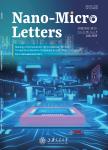Bi Nanoparticles Anchored in N-Doped Porous Carbon as Anode of High Energy Density Lithium Ion Battery
Bi Nanoparticles Anchored in N-Doped Porous Carbon as Anode of High Energy Density Lithium Ion Battery作者机构:School of Chemistry and Environment South China Normal University Engineering Research Center of MTEES (Ministry of Education) Research Center of BMET (Guangdong Province) Engineering Laboratory of OFMHEB (Guangdong Province) Key Laboratory of ETESPG (GHEI) and Innovative Platform for ITBMD (Guangzhou Municipality)South China Normal University Department of Chemical and Bimolecular EngineeringUniversity of MarylandCollege Park
出 版 物:《Nano-Micro Letters》 (纳微快报(英文版))
年 卷 期:2018年第10卷第4期
页 面:10-23页
核心收录:
学科分类:0808[工学-电气工程] 0809[工学-电子科学与技术(可授工学、理学学位)] 0817[工学-化学工程与技术] 08[工学] 0805[工学-材料科学与工程(可授工学、理学学位)] 080502[工学-材料学] 0702[理学-物理学]
基 金:supported by the Natural Science Foundation of Guangdong Province (Grant No.2017B030306013) the key project of Science and Technology in Guangdong Province (Grant No.2017A010106006)
主 题:Porous N-doped carbon Bi nanoparticles Anode Lithium-ion battery High energy density
摘 要:A novel bismuth–carbon composite, in which bismuth nanoparticles were anchored in a nitrogen-doped carbon matrix(Bi@NC), is proposed as anode for high volumetric energy density lithium ion batteries(LIBs).Bi@NC composite was synthesized via carbonization of Zn-containing zeolitic imidazolate(ZIF-8) and replacement of Zn with Bi, resulting in the N-doped carbon that was hierarchically porous and anchored with Bi nanoparticles. The matrix provides a highly electronic conductive network that facilitates the lithiation/delithiation of ***, it restrains aggregation of Bi nanoparticles and serves as a buffer layer to alleviate the mechanical strain of Bi nanoparticles upon Li insertion/*** these contributions, Bi@NC exhibits excellent cycling stability and rate capacity compared to bare Bi nanoparticles or their simple composites with carbon. This study provides a new approach for fabricating high volumetric energy density LIBs.



